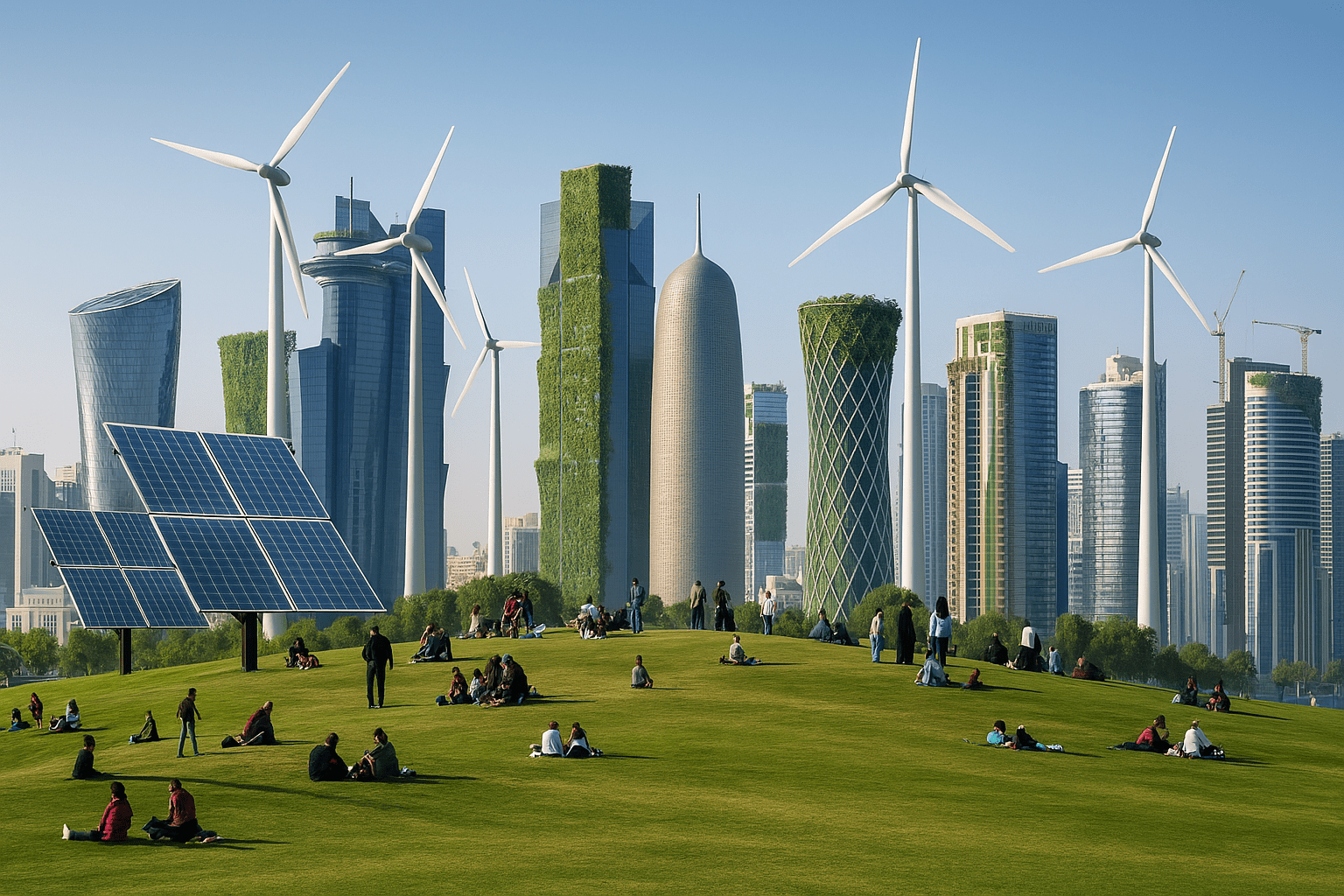
Introduction: Understanding Qatar's Approach to Mitigating Carbon Emissions and Climate Change
April 2025
Recognizing the grave threat that climate change poses to people and the planet, the 2015 Paris Agreement, adopted at the United Nations Framework Convention on Climate Change’s (UNFCCC) Conference of the Parties (COP21), set an overarching goal of limiting the increase in average global temperature to 1.5°C above pre-industrial levels. However, as greenhouse gas (GHG) emissions have continued to increase, this threshold will certainly be surpassed,1 placing the world at greater risk of ecological crises and extreme weather events. Indeed, 2024 was the warmest year on record, with average global temperatures at around 1.55°C above pre-industrial levels.2
It will take a concerted and coordinated global effort to mitigate the potential negative impact of climate change, and Qatar has the potential to play a leading role on climate action. During the 1990s, Qatar pioneered the production and export of liquified natural gas (LNG), a transition fuel that is cleaner than coal and oil in terms of end use emissions. The gamble paid off, allowing natural gas to replace dirtier coal in many parts of the world and, in the process, helping Qatar become one of the world’s wealthiest countries and placing it in a unique position to support global emissions reduction efforts.
Qatar’s wealth paved the way for accelerated economic development. Between 1995 and 2015, Gross Domestic Product (GDP) increased from under 20 billion USD to over 160 billion USD (in constant 2015 US dollars) and its population quadrupled from 650,000 in 2000 to over 2.7 million by 2017.3 However, this rapid growth and expansion had a downside; Qatar became one of the world’s highest emitters of GHGs in per capita terms. That said, relative to GDP, Qatar’s GHG emissions are lower than the average for all but one of the countries of the Gulf Cooperation Council (GCC).4 Furthermore, as a small country, Qatar’s contribution to global emissions is minimal, representing only 0.3 percent of the total.5 Qatar is neither the source of the problem nor the core of a solution. Yet, it has committed to play its part.
Qatar’s National Vision 2030 emphasizes the importance of balancing development needs with environmental protection, including through supporting international efforts to mitigate the impacts of climate change.6. In 2021, Qatar launched its National Climate Change Action Plan aimed at reducing greenhouse gas emissions by 25% (vs. business as usual) by 2030. The plan also identified 36 climate change adaptation measures and over 300 initiatives. In 2024, Qatar’s Third National Development Strategy called for the scaling up of carbon capture technologies, the adoption of renewable energy (increasing existing capacity to 4-Gigawatt), and the introduction of energy consumption reduction and efficiency measures.7
Over the past two decades, Qatar has invested heavily in building its knowledge base and technical capacity to tackle environmental and climate change issues. The Qatar Environment and Energy Research Institute (QEERI) was established in 2010, the Ministry of Environment and Climate Change was established in 2021, and Earthna: Center for a Sustainable Future was established in 2022. Qatar also hosts the Global Carbon Council (GCC), the first international carbon credit program based in the Global South, established by the Gulf Organisation for Research and Development (GORD) in 2016.
Drawing on the wealth of local expertise, in September 2024, the Middle East Council on Global Affairs and Earthna: Center for a Sustainable Future organized a policy workshop to explore pragmatic approaches to carbon emissions mitigation and reduction that align with Qatar’s National Vision 2030, its socio-economic context, and its environmental imperatives. The workshop brought together a group of scholars focused on studying emissions reduction strategies to explore the policy implications of their research. A group of policy experts and advisors from the Ministry of Environment and Climate Change, Qatar Foundation, Al-Attiyah Foundation, and other institutions joined the discussion.
Following the workshop, several participants agreed to collaborate to publish a dossier focused on carbon emissions reductions strategies for Qatar. Twenty scholars joined this effort, producing a total of ten chapters, grouped into three sections.
Section 1 examines the interplay between carbon emissions reduction and Qatar’s economy. It includes three chapters. The first, authored by Muez Ali, Abdalftah Hamed Ali, Gonzalo Castro de la Mata, and Alex Amato, discusses the role of Qatar’s LNG exports in offsetting emissions globally. The second, by Dhabia M. Al-Mohannadi and Beverley Milton-Edwards, is on energy exports and the low carbon technology debate. The third, authored by Marcello Contestabile, Pankaj Kumar, Carlos Mendez and Maroua Benlahrech, outlines Qatar’s pathways to decarbonization and economic diversification.
Section 2 examines carbon alternatives and low carbon technologies in Qatar. It includes four chapters: a chapter on the prospects for solar energy by Justin Dargin, a chapter on nuclear energy’s role in decarbonization by S. Duygu Sever, a chapter on hydrogen’s role as a catalyst for emissions reduction by Aisha Al-Sarihi, and a chapter on reducing carbon emissions from desalination by Deema Almasri and Mohammad Abu Hawash.
Finally, section 3 examines carbon markets. It includes a chapter on the role of carbon markets in the Paris Agreement and implications for Qatar by Alexandra Soezer, a chapter on carbon markets and emission reduction strategies for achieving net zero emissions in the Middle East and North Africa (MENA) region by Neeshad Shafi, and a chapter on carbon markets as a decarbonization pathway by Omer F. Agca and Ahmet F. Aysan.
Taken together, the dossier chapters explore a wide range of issues related to Qatar’s emissions mitigation efforts. The dossier also highlights the progress being made and potential areas of exploration that policy actors in Qatar might pursue to help the country achieve its emissions reduction targets, thus fulfilling its part in global decarbonization efforts to mitigate the negative implications of climate change.
Endnote



